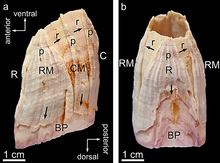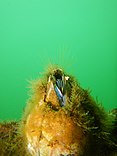| Austromegabalanus psittacus | |
|---|---|

| |
| Exoskeleton (shell) of the giant barnacle | |
| Scientific classification | |
| Domain: | Eukaryota |
| Kingdom: | Animalia |
| Phylum: | Arthropoda |
| Class: | Thecostraca |
| Subclass: | Cirripedia |
| Order: | Balanomorpha |
| Family: | Balanidae |
| Genus: | Austromegabalanus |
| Species: | A. psittacus |
| Binomial name | |
| Austromegabalanus psittacus (Molina, 1782) | |
Austromegabalanus psittacus, the giant barnacle or picoroco as it is known in Spanish, is a species of large barnacle native to the coasts of southern Peru, all of Chile and southern Argentina. It inhabits the littoral and intertidal zones of rocky shores and normally grows up to 30 centimetres (12 in) tall with a mineralized shell composed of calcite. The picoroco barnacle is used in Chilean cuisine and is one of the ingredients in curanto.
Description
Austromegabalanus psittacus is a large sessile barnacle that lives in groups on hard substrates. It has a tall cone-shaped carapace composed of twelve large plates made of calcite microcrystals which are cemented together. The basal disc is firmly cemented to a hard surface. It grows to a height of 30 centimetres (12 in). There is an opening at the top with a hinged operculum through which the thoracic limbs known as "cirri" protrude. The general colour is dull white with purple and brown markings.
Biology

 A. psittacus at rest (left) and later using its cirri (right) for filter feeding
A. psittacus at rest (left) and later using its cirri (right) for filter feeding
Austromegabalanus psittacus is a simultaneous hermaphrodite. Individual barnacles are fertilised by sperm passed through a slender tube extended by a neighbouring barnacle. The eggs are retained inside the carapace where they are incubated for about three or four weeks. They then hatch into free swimming nauplius larvae which form part of the plankton. These pass through six stages over the course of about 45 days, the last being a cyprid stage. These larvae are about 1 mm (0.04 in) long and settle on the seabed, usually in the proximity of other barnacles.
Often the larvae settle so close together that hummocks are formed as the juvenile barnacles grow. Under these circumstances the calcareous base becomes modified into a more porous, cylindrical form above which the carapaces tower, the central individuals being about twice as tall as the outside ones. The density of the barnacles in the hummocks can be more than 1000 individuals per square metre (11 sq ft). This ability to form hummocks give this species an advantage when they are competing for space with other species of barnacle. It is an omnivorous filter feeder.
Distribution
Austromegabalanus psittacus is a coastal species found in southern Peru, along the entire length of Chile (including offshore Juan Fernández Islands) and southern Argentina in the intertidal and littoral zone. It is recorded at depths of 0–35 m (0–115 ft), but is mostly found at 2–20 m (7–66 ft). It is most common in the Los Lagos area in Chile and is harvested for human consumption, mainly in the towns of Calbuco, Carelmapu and Puerto Montt.
Use by humans and oceanic organisms

This barnacle forms part of Chilean cuisine. Its meat is highly prized and is one of the ingredients of the Chilean dish curanto. This is traditionally made from various seafood ingredients cooked in a large pit preheated with red-hot stones. Modern cooking methods use a large pot, conventionally heated.
Overfishing has reduced the quantities of Austromegabalanus psittacus available for commercial harvesting. There are plans to cultivate it along the coast of Chile and there are possibilities of exporting it to Japan.
In addition to humans, it is sometimes eaten by the sea star Heliaster helianthus and the clingfish Sicyases sanguineus, although the latter only can prey on small animals (large Austromegabalanus psittacus are apparently safe).
References
- Chan, Benny K.K. (2012). "Austromegabalanus psittacus (Molina, 1788)". WoRMS. World Register of Marine Species. Retrieved 2013-01-01.
- Robert W. Simpfendörfer; Karin B. Oelckers; David Nash; Daniel A. López (2005). "Kinetic properties of the muscular pyruvate kinase from the giant marine barnacle, Austromegabalanus psittacus (Molina, 1782) (Cirripedia, Balanomorpha)". Crustaceana. 78 (10): 1203–1218. doi:10.1163/156854005775903573.
- ^ López, Daniel A.; López, Boris A.; Arriagada, Sergio E.; González, María L.; Mora, Oscar A.; Bedecarratz, Paula C.; Pineda, Mauricio O.; Andrade, Lorenzo I.; Uribe, José M.; Riquelme, Verónica A. (2012). "Diversification of Chilean aquaculture: the case of the giant barnacle Austromegabalanus psittacus (Molina, 1782)". Latin American Journal of Aquatic Research. 40 (3): 596–607. doi:10.3856/vol40-issue3-fulltext-9.
- Alejandro B. Rodríguez-Navarro; Christiane CabraldeMelo; Nelson Batista; Nilton Morimoto; Pedro Alvarez-Lloret; Miguel Ortega-Huertas; Victor M. Fuenzalida; Jose I. Arias; Juan P. Wiff; Jose L. Arias (2006). "Microstructure and crystallographic-texture of giant barnacle (Austromegabalanus psittacus) shell". Journal of Structural Biology. 156 (2): 355–362. doi:10.1016/j.jsb.2006.04.009. PMID 16962792.
- Rodrıguez-Navarro, Alejandro B.; CabraldeMelo, Christiane; Batista, Nelson; Morimoto, Nilton; Alvarez-Lloret, Pedro; Ortega-Huertas, Miguel; Fuenzalida, Victor M.; Arias, Jose I.; Wiff, Juan P.; Arias, Jose L. (2006). "Microstructure and crystallographic-texture of giant barnacle (Austromegabalanus psittacus) shell" (PDF). Journal of Structural Biology. 156 (2): 355–362. doi:10.1016/j.jsb.2006.04.009. PMID 16962792.
- ^ López, Daniel A.; López, Boris A.; Burgos, Ignacia C.; Arriagada, Sergio E.; González, María L. (2007). "Consequences of base modification in hummocks of the barnacle Austromegabalanus psittacus". New Zealand Journal of Marine and Freshwater Research. 41 (3): 291–298. doi:10.1080/00288330709509916. S2CID 84436972.
- ^ Palomares ML, Pauly D, eds. (2018). "Austromegabalanus psittacus" in SeaLifeBase. October 2018 version.
- ^ Carolina J. Zagal; Consuelo Hermosilla C. (2007). Guía de Invertebrados marinos del sur de Chile. Editorial Fantástico Sur, Punta Arenas, Chile. p. 149. ISBN 978-956-8007-19-5.
- "El picoroco!". Restaurant La Barca (in Spanish). Archived from the original on 2016-01-12. Retrieved 2013-01-02.)
- "The curanto". ThinkQuest. Archived from the original on 2013-06-24. Retrieved 2013-01-02.
- Paine, R.T.; A.R. Palmer (1978). "Sicyases sanguineus: a Unique Trophic Generalist from the Chilean Intertidal Zone". Copeia. 1978 (1): 75–81. doi:10.2307/1443824. JSTOR 1443824.
| Taxon identifiers | |
|---|---|
| Austromegabalanus psittacus | |